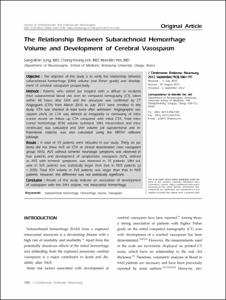KUMEL Repository
1. Journal Papers (연구논문)
1. School of Medicine (의과대학)
Dept. of Neurosurgery (신경외과학)
(The)relationship between subarachnoid hemorrhage volume and development of cerebral vasospasm
- Keimyung Author(s)
- Yim, Man Bin; Lee, Chang Young
- Department
- Dept. of Neurosurgery (신경외과학)
- Journal Title
- 대한뇌혈관외과학회지
- Issued Date
- 2012
- Volume
- 14
- Issue
- 3
- Abstract
- OBJECTIVE:
The objective of this study is to verify the relationship between subarachnoid hemorrhage (SAH) volume (not Fisher grade) and development of cerebral vasospasm prospectively.
METHODS:
Patients who visited our hospital with a diffuse or localized thick subarachnoid blood clot seen on computed tomography (CT), taken within 48 hours after SAH and the aneurysm was confirmed by CT Angiogram (CTA) from March 2010 to July 2011 were enrolled in this study. CTA was checked at least twice after admission. Angiographic vasospasm (AVS) on CTA was defined as irregularity or narrowing of intracranial vessels on follow up CTA compared with initial CTA. Total intracranial hemorrhage (ICH) volume (subdural, SAH, intracerebral and intraventricular) was calculated and SAH volume (all supratentorial and infratentorial cisterns) was also calculated using the MIPAV software package.
RESULTS:
A total of 55 patients were included in our study. Thirty six patients did not show AVS on CTA or clinical deterioration (non vasospasm group: NVS). AVS without ischemic neurologic symptoms was observed in four patients and development of symptomatic vasospasm (SVS), defined as AVS with ischemic symptoms, was observed in 15 patients. SAH volume in SVS patients was statistically larger than that in NVS patients (p < 0.05). Total ICH volume in SVS patients was larger than that in NVS patients. However, the difference was not statistically significant.
- Publisher
- School of Medicine
- Citation
- Sang-Won Jung et al. (2012). (The)relationship between subarachnoid hemorrhage volume and development of cerebral vasospasm. 대한뇌혈관외과학회지, 14(3), 186–191. doi: 10.7461/jcen.2012.14.3.186
- Type
- Article
- ISSN
- 1738-0499
- Appears in Collections:
- 1. School of Medicine (의과대학) > Dept. of Neurosurgery (신경외과학)
- 파일 목록
-
-
Download
 oak-bbb-05395.pdf
기타 데이터 / 178.81 kB / Adobe PDF
oak-bbb-05395.pdf
기타 데이터 / 178.81 kB / Adobe PDF
-
Items in Repository are protected by copyright, with all rights reserved, unless otherwise indicated.